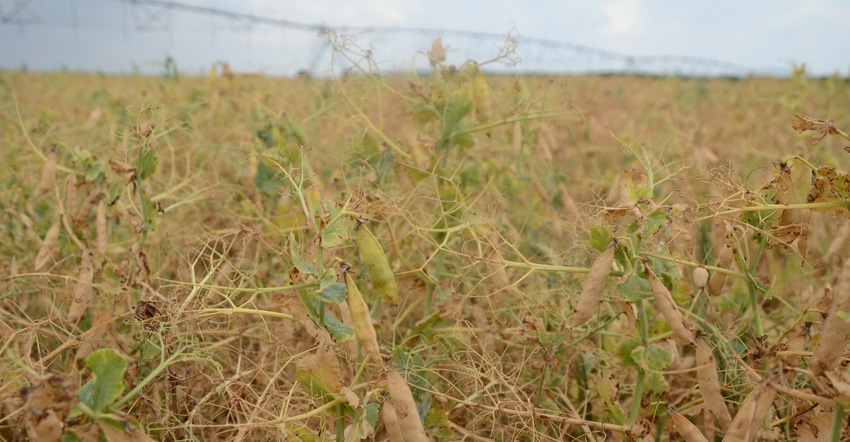
Nebraska has enjoyed an increase in pulse crop production over the last few years, thanks in large part to the growth in yellow field pea acres across the state.
In 2017, the combined acreage of field peas, lentils and chickpeas in Nebraska increased to about 80,000 acres. Meanwhile, more processors in the state, including New Alliance, Gavilon Grain and Redwood, are handling field peas and other pulse crops.
As Nebraska's pulse crops industry grows, Strahinja Stepanovic, Nebraska Extension educator, notes a pulse crop checkoff could be one way to keep the industry moving forward.
Whether or not a pulse crop checkoff is formed, however, is up to growers. Stepanovic recently sent a survey to growers asking, among other things, whether or not the state should create a "Nebraska Pulse Crop Checkoff."
Before the state creates its own checkoff, a few questions must be answered, such as whether board members should be appointed or elected. The survey Stepanovic sent to growers includes questions on the legislative process for choosing board members, board member term lengths and the number of board members.
If growers decide to create a state checkoff, they would also have the opportunity to join the National Pulse Crops Coalition — a group administered by the USA Dry Pea and Lentil Council and the American Pulse Association, which includes pulse growers in North Dakota, South Dakota, Montana, Idaho and Washington state.
To participate in the national coalition, the Nebraska Pulse Crop Checkoff would pay an annual assessment of 1% of net pulse crop sales from first purchasers in the state, as well as an annual membership fee — a minimum of $10,000. If the state checkoff decides to remain independent, they can choose to set the assessment at a lower percentage, base it on the number of bushels sold, or use another form of funding.
However, there are benefits to joining the national coalition. For example, assessment funds would be controlled by the Nebraska Pulse Crop Checkoff board, and focus on marketing, research and education efforts. Meanwhile, joining the National Pulse Crops Coalition would provide access to revenue insurance for pulse crops through the coalition.
Currently, federal crop insurance through USDA's Risk Management Agency is available to pulse growers in the Panhandle and certain southwest Nebraska counties. Growers outside that region can get yield protection through a written agreement, but that requires a history of a similar crop (small-grain cereal or pulse crop) grown on the farm for at least three years over the past 30 years.
"Most farmers that are starting out growing pulses don’t have historic yield averages, and will have to be satisfied with yield protection for only 900 pounds per acre, or 15 bushels per acre until their yield average gradually changes," Stepanovic says. "And if they are in central and eastern Nebraska, they must wait on RMA to expand insurance to their area over time."
"If we decide to join the National Pulse Growers Coalition, they provide the revenue insurance," he adds. "The state would get a revenue insurance program, which includes projected prices set for each pulse crop, and for both organic and conventional by the national program."
If the state checkoff decides to join the national organization, there's also the question whether to contribute more to the national organization, or to keep more checkoff dollars in-state.
For example, with an estimated annual budget of $70,000 and about $20,000 in administrative fees, would it be best to devote the remaining $50,000 to the national coalition, or just pay the minimum $10,000 to get revenue insurance to keep the rest of the checkoff dollars in-state?
The state checkoff can also apply for research grants from the national organization, which may be a more attractive option if the state devotes more of its funds to national research.
Checkoff dollars can be spent on a number of things, and Stepanovic notes one area is breeding new public varieties with greater heat tolerance — by far the biggest challenge faced in field pea production. "If we have a local, public variety that can tolerate high temperatures, lower humidity, high winds at flowering and raise yield potential by 20% to 30%, and if that seed is available to growers at a competitive price, imagine what that would do for those who decide to grow it," he says.
However, the decision of whether or not to create a state checkoff is ultimately up to growers, and Stepanovic notes as a fairly young ag sector, some form of platform to help promote the industry would be beneficial.
"Pulse crop production is expanding to more farmers, and the needs for research are growing," he says. "It's up to farmers to decide how we want to promote this industry in Nebraska. Do we want to create a checkoff, or do something different? The university will support whatever our growers decide."
Interested growers can learn more and fill out a survey by contacting Stepanovic at [email protected].
About the Author(s)
You May Also Like






